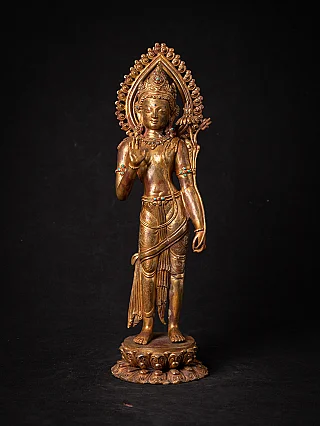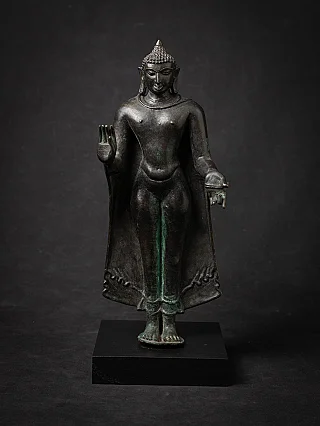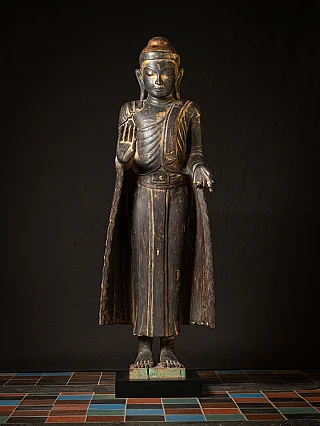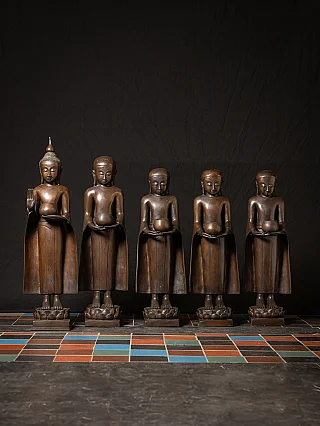Abhaya Mudra

Abhaya Mudra, one of Buddhist iconography's most significant hand gestures, holds profound meaning and symbolism. This ancient gesture, often depicted in Buddha statues, represents protection, peace, and the dispelling of fear. For centuries, Abhaya Mudra (mudra of no fear) has been a powerful emblem in Buddhist art and practice, captivating the minds and hearts of those who seek solace and strength.
Historical Background
The term "Abhaya" derives from the Sanskrit word for "fearlessness" or "fearlessness gesture." The Abhaya Mudra is believed to have originated in ancient India and is one of the earliest mudras used in Buddhist practice. Its first known depiction dates back to the Gandhara period (1st-3rd century CE), where Buddhist art flourished, blending Hellenistic and Indian influences.
Historically, Abhaya Mudra was used by the Buddha himself. According to Buddhist tradition, the Buddha performed this gesture after enlightenment to calm a raging elephant set upon him by a jealous rival. This act subdued the animal and symbolized the Buddha's ability to bring peace and protection to all beings.
Symbolism and Meaning
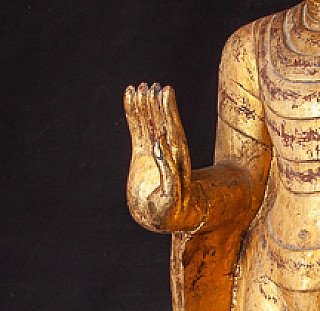
Abhaya Mudra is performed with the right hand raised to shoulder height, palm facing outward, and fingers extended upward. The left hand typically rests at the side or in the lap. This gesture is rich in symbolism, conveying several vital messages:
- Protection: The raised hand acts as a shield, offering protection from fear, danger, and negative influences.
- Reassurance: It assures the devotee of the Buddha's compassionate presence and ability to provide safety and security.
- Fearlessness encourages the practitioner to overcome personal fears and challenges, promoting inner strength and confidence.
- Peace: The open palm signifies openness
Cultural Context
The Abhaya Mudra is prevalent across various Buddhist traditions, each interpreting its significance within their cultural and doctrinal frameworks. In Theravada Buddhism, primarily practiced in Sri Lanka, Thailand, and Myanmar, this mudra is commonly seen in standing or walking Buddha statues, emphasizing the Buddha's role as a protector.
In Mahayana Buddhism, prevalent in China, Japan, and Korea, Abhaya Mudra is often combined with other mudras, reflecting a more elaborate iconographic tradition. With its rich artistic heritage, Tibetan Buddhism frequently portrays deities and bodhisattvas in Abhaya Mudra, symbolizing their protective and compassionate nature.
Physical Description
The Abhaya Mudra is straightforward in its execution but profound in its depiction. Here is a detailed description of the hand position:
- Right Hand: Raised to shoulder height, palm facing outward, fingers together and extended upward.
- Left Hand: Resting at the side or lap, often in Dhyana Mudra (meditation gesture) when seated.
Variations of Abhaya Mudra can be found in different cultures and artistic styles. In some representations, the fingers may be slightly bent, or the hand may be positioned at various heights, but the essential meaning remains.
Significance in Practice
Exclusive statues in our gallery
Abhaya Mudra plays a crucial role in Buddhist practice and meditation. It reminds practitioners of the Buddha's teachings on fearlessness and compassion. Practitioners often visualize this mudra during meditation to cultivate inner peace and security.
Numerous stories and teachings in Buddhist literature highlight the importance of Abhaya Mudra. For instance, the Jataka tales, which recount the Buddha's previous lives, frequently describe the Buddha using this gesture to protect and reassure others, reinforcing its association with safety and benevolence.
Abhaya Mudra in Art

Abhaya Mudra is a common motif in Buddhist art, found in sculptures, paintings, and reliefs. Famous examples include the Sarnath Buddha statue in India and the massive Buddha at Gal Vihara in Sri Lanka. These masterpieces showcase the mudra's aesthetic appeal and spiritual significance.
When identifying Abhaya Mudra in art, look for the distinctive raised right hand with the palm facing outward. This gesture is often accompanied by a serene and compassionate expression on the Buddha's face, reinforcing the mudra's message of peace and protection.
Modern Relevance
In contemporary times, Abhaya Mudra continues to resonate with people worldwide. It is embraced not only by Buddhists but also by individuals seeking calm and confidence in their daily lives. The gesture's universal message of fearlessness and reassurance transcends religious boundaries, making it relevant in various contexts, from yoga and mindfulness practices to modern art and design.
Abhaya Mudra's presence in modern culture is evident in its depiction in contemporary artworks, tattoos, and even fashion. It is a powerful reminder of the Buddha's timeless wisdom and the enduring relevance of his teachings.
Conclusion
With its profound symbolism and rich history, Abhaya Mudra remains a powerful gesture of protection, fearlessness, and peace. Whether depicted in ancient sculptures or embraced in modern practices, this mudra inspires and comforts those who encounter it. As we explore the world of Buddha statues and Buddhist art, may the Abhaya Mudra guide us toward a deeper understanding of the Buddha's teachings and the timeless quest for inner peace.
Share this page



















